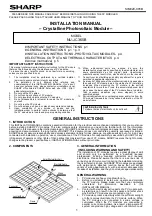
SIM02E-005B
4
INSTALLATION INSTRUCTIONS -PHOTOVOLTAIC MODULES-
1. INSTALLATION
Mounting Using Clamps:
The PV modules can be mounted with clamps (clips) as defined in the
following. Note that the mounting clamps should meet the required
dimensions as defined in the Figure1. Note that the
CLAMP CENTER
POSITION
from the module corner should be located in the range as
specified in the Annex. All clamps shall hold the module frame completely
within their width. Please be aware that the module under heavy load would
get serious deflection which could cause cell cracks that affects power
degradation. The PV module must be supported on the array system and
must overlap the array rail by at least 10mm.
Mounting Using Frame Bolt Holes:
The modules may be fastened to a support using the bolt holes in the bottom
of the frames at any of locations shown in the Annex. The module should be
fastened with M8 bolts. Recommended torque is 12.5 Nm.
2. ELECTRICAL INSTALLATION INSTRUCTION
Cable characteristics
Conductor size: 4.0mm
2
, Cable type: XLPE cable (H1Z2Z2-K)
Maximum DC voltage: 1.5kV
Ambient temperature: -40°C to +90°C
Maximum conductor temperature: 120 °C
PV module configuration (Recommend)
# Maximum series configuration: please refer to Table 1
# Maximum parallel configuration: (Parallel connection of each
string shall be conducted with following two options. Any other
parallel connections are prohibited.)
a) Case of using the diodes; 1 diode per maximum 2 parallel
strings (Connect a diode or more in series for every string or
every 2 parallel strings for protection of PV module from
reverse current over load.)
b) Case of using the fuses; 1 fuse per every string (Connect a
fuse for every single string for protection of PV module from
reverse current over load.)
Connection cables requirement
The PV module shall be mated to the same connectors;
Type: MC4
(
System voltage 1,000V
)
Brand: Staubli Electrical Connectors
In case connectors will be replaced by qualified personnel
according the mounting instructions of the manufacturer of the
new connectors, the guarantees on the module itself, will
remain valid according the applicable terms.
3. WARNING
Keep all PV MODULES and electrical CONNECTORS clean &
dry before installation.
4. Disposal
Dispose PV modules properly. For
Information
about
the
proper
disposal, contact your local recycling
site.
ELECTRICAL OUTPUT AND THERMAL CHARACTERISTICS
Rated electrical characteristics are within ±10 percent of the indicated values of Voc, Isc and +5/-0 percent of Pmax , under STC
(standard test conditions) (irradiance of 1000W/m
2
, AM 1.5 spectrum, and a cell temperature of 25°C (77°F)).
Table-1. Electrical characteristics (at STC)
Model
name
Max imum
Power
(Pmax )
Tolerance
Open-Curcuit
Voltage
(Voc)
Short-Circuit
Current
(Isc)
Voltage at point
of max . Power
(Vmpp)
Current at point
of max . Power
(Impp)
Max imum
system voltage
Over-Current
Protection
Class for protection
against elecrical
shock
Max imum series
configuration(*)
NU-JC365B
365W
+5%/-0%
40.56V
11.46A
34.18V
10.68A
1,000V
20A
Ⅱ
20
* The maximum series number of modules depends on the local conditions. These values are calculated under the condition of Voc at -40 °C.
Under normal conditions, a PV module is likely to experience conditions that produce more current and/or voltage than reported
at Standard Test Conditions. Accordingly, the values of Isc and Voc marked on this PV module should be multiplied by a factor
of 1.25 when determining component voltage ratings, conductor current ratings, fuse sizes and size of controls connected to the
PV module output.
The PV module has been qualified in an environmental temperature range of -40 °C to +40 °C and up to 100% relative humidity
as well as rain, and the altitude up to 2,000m in accordance with IEC61730.
Class for protection against electric shock
This PV module is classified
as “Class
Ⅱ
” according to
IEC61730. These PV modules are intended for installation
where general user access and contact to insulated live parts is
anticipated.
FIRE RATING
This PV module
is rated as “Fire safety class C” according to
IEC61730-2:2004 or UL790.
Figure1. Clamps (Clips) requirement
1) Clamp: Al alloy, 3 mm Min. thickness
2) Catch length (50 mm Min.)
3) Covering depth (7 mm Min. on the frame)
4) Supporting depth (10 mm Min.)
5) Frame (applicable to all frame sections)
6) Array rail
(applicable to parallel or crossed mounting)























